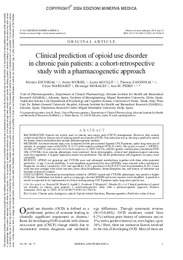Please use this identifier to cite or link to this item:
https://hdl.handle.net/11000/32356Full metadata record
| DC Field | Value | Language |
|---|---|---|
| dc.contributor.author | Escorial, Mónica | - |
| dc.contributor.author | Muriel, Javier | - |
| dc.contributor.author | Agulló, Laura | - |
| dc.contributor.author | Zandonai, Thomas | - |
| dc.contributor.author | Margarit, César | - |
| dc.contributor.author | Morales, Domingo | - |
| dc.contributor.author | Peiró, Ana | - |
| dc.contributor.other | Departamentos de la UMH::Farmacología, Pediatría y Química Orgánica | es_ES |
| dc.date.accessioned | 2024-06-27T10:54:53Z | - |
| dc.date.available | 2024-06-27T10:54:53Z | - |
| dc.date.created | 2024-04-12 | - |
| dc.identifier.citation | Minerva Anestesiologica. 2024 May;90(5):386-396. | es_ES |
| dc.identifier.issn | 0375-9393 | - |
| dc.identifier.issn | 1827-1596 | - |
| dc.identifier.uri | https://hdl.handle.net/11000/32356 | - |
| dc.description.abstract | BACKGROUND: opioids are widely used in chronic non-cancer pain (cNcP) management. However, they remain controversial due to serious risk of causing opioid use disorder (oUD). our main aim was to develop a predictive model for future clinical translation that include pharmacogenetic markers. METHODS: an observational study was conducted in 806 pre-screened spanish cNcP patients, under long-term use of opioids, to compare cases (with oUD, N.=137) with controls (without oUD, N.=669). Mu-opioid receptor 1 (OPRM1, a118g, rs1799971) and catechol-O-methyltransferase (COMT, g472a, rs4680) genetic variants plus cytochrome P4502D6 (cYP2D6) liver enzyme phenotypes were analyzed. socio-demographic, clinical and pharmacological outcomes were also registered. a logistic regression model was performed. the model performance and diagnostic accuracy were calculated. RESULTS: OPRM1-AA genotype and cYP2D6 poor and ultrarapid metabolizers together with three other potential predictors: 1) age; 2) work disability; 3) oral morphine equivalent daily dose (MeDD), were selected with a satisfactory diagnostic accuracy (sensitivity: 0.82 and specificity: 0.85), goodness of fit (P=0.87) and discrimination (0.89). Cases were ten-year younger with lower incomes, more sleep disturbances, benzodiazepines use, and history of substance use disorder in front of controls. CONCLUSIONS: Functional polymorphisms related to OPRM1 variant and cYP2D6 phenotypes may predict a higher OUD risk. Established risk factors such as young age, elevated MEDD and lower incomes were identified. A predictive model is expected to be implemented in clinical setting among cNcP patients under long-term opioids use. | es_ES |
| dc.format | application/pdf | es_ES |
| dc.format.extent | 16 | es_ES |
| dc.language.iso | eng | es_ES |
| dc.publisher | EDIZIONI MINERVA MEDICA | es_ES |
| dc.rights | info:eu-repo/semantics/openAccess | es_ES |
| dc.rights.uri | http://creativecommons.org/licenses/by-nc-nd/4.0/ | * |
| dc.subject | chronic pain | es_ES |
| dc.subject | analgesics | es_ES |
| dc.subject | opioid | es_ES |
| dc.subject | opioid-related disorders | es_ES |
| dc.subject | Pharmacogenetics | es_ES |
| dc.subject | Predictive value of tests | es_ES |
| dc.subject.other | CDU::6 - Ciencias aplicadas::61 - Medicina::615 - Farmacología. Terapéutica. Toxicología. Radiología | es_ES |
| dc.title | Clinical prediction of opioid use disorder in chronic pain patients: a cohort-retrospective study with a pharmacogenetic approach | es_ES |
| dc.type | info:eu-repo/semantics/article | es_ES |
| dc.contributor.institute | Institutos de la UMH::Instituto de Bioingeniería | es_ES |
| dc.contributor.institute | Institutos de la UMH::Instituto Centro de Investigación Operativa | es_ES |
| dc.relation.publisherversion | https://doi.org/10.23736/S0375-9393.24.17864-9 | es_ES |

View/Open:
Clinical prediction of opioid use disorder in chronic pain patients. A cohort-retrospective study with a pharmacogenetic approach.pdf
2,15 MB
Adobe PDF
Share:
.png)
